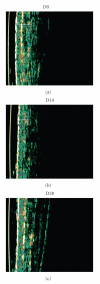An experimental in vivo model to characterize "heavy legs" symptom in topical formulations
- PMID: 20585480
- PMCID: PMC2877621
- DOI: 10.1155/2009/547039
An experimental in vivo model to characterize "heavy legs" symptom in topical formulations
Abstract
The "Heavy legs" symptom is regarded as an early expression of chronic venous failure, estimated to affect 40% of the population in developing countries. A new methodology is proposed to approach the "tired or heavy legs" symptom. Seven females with this complaint applied a standard topical formulation during 28 days in one leg randomly chosen. Local blood flow records were obtained instantaneously and during postural change with a laser doppler flowmeter (LDF). High-frequency sonography and local morphometry were also obtained at Days 0, 14, and 28. When compared with D0, LDF values present a significant decrease of both basal and dynamical values after Day 14 and Day 28 suggesting that this effect may result from the formulation application, also involving the related massage. Centimetric measurements and sonographic analysis also supported those inferences. The proposed methodology can evaluate the dynamical changes of "heavy legs" symptom and eventually be very useful to assess the related claim support.
Figures



Similar articles
-
Dynamics of cutaneous laser Doppler flux with concentration of moving blood cells and blood cell velocity in legs with venous ulcers and in healthy legs.Angiology. 2004 Jan-Feb;55(1):37-42. doi: 10.1177/000331970405500106. Angiology. 2004. PMID: 14759088
-
Regarding the quantification of peripheral microcirculation--Comparing responses evoked in the in vivo human lower limb by postural changes, suprasystolic occlusion and oxygen breathing.Microvasc Res. 2015 May;99:110-7. doi: 10.1016/j.mvr.2015.04.001. Epub 2015 Apr 11. Microvasc Res. 2015. PMID: 25872021
-
Blood flux and venoarteriolar response of the skin in legs with chronic venous insufficiency measured at two different depths by using a double-wavelength laser Doppler technique.Angiology. 1998 Jun;49(6):441-6. doi: 10.1177/000331979804900604. Angiology. 1998. PMID: 9631889
-
[Evaluation of clinical efficacy of a venotonic drug: lessons of a therapeutic trial with hemisynthesis diosmin in "heavy legs syndrome"].J Mal Vasc. 1998 Apr;23(2):106-12. J Mal Vasc. 1998. PMID: 9608923 Clinical Trial. French.
-
Regional distribution of optic nerve head blood flow.Graefes Arch Clin Exp Ophthalmol. 1999 Jun;237(6):484-8. doi: 10.1007/s004170050266. Graefes Arch Clin Exp Ophthalmol. 1999. PMID: 10379609 Clinical Trial.
References
-
- Chiesa R, Marone EM, Limoni C, Volonté M, Schaefer E, Petrini O. Effect of chronic venous insufficiency on activities of daily living and quality of life: correlation of demographic factors with duplex ultrasonography findings. Angiology. 2007;58(4):440–449. - PubMed
-
- Callejas JM, Manasanch J, Abad R, et al. Epidemiology of chronic venous insufficiency of the lower limbs in the primary care setting. International Angiology. 2004;23(2):154–163. - PubMed
-
- Young S. Regulatory assessment of cosmetic product. In: Leyden J, Rawlings A, editors. Skin Moisturization, Cosmetic Science and Technologies Series. New York, NY, USA: Marcel Dekker; 2002. pp. 635–650.
-
- Rogiers V. Efficacy claims of cosmetics in Europe must be scientifically substantiated from 1997. Skin Research and Technology. 1995;1(1):44–46. - PubMed
-
- Bahr C. CVI and PAD: a review of venous and arterial disease. JAAPA. 2007;20(8):20–25. - PubMed
LinkOut - more resources
Full Text Sources

